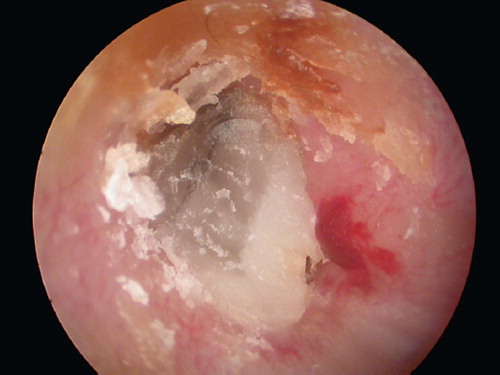Abstract
We describe a case of ear candling presenting as hearing loss, and review the literature. Ear candling is considered as an alternate medical therapy for dewaxing the ears, discomfort in ears and sinuses, rhinitis, sinusitis, glue ear, colds, flu, migraines, poor or “muffled” hearing, high stress, and ringing in the ear. There is no evidence of its effectiveness, and it can actually cause damage to the ears.
Key words::
Case report
A 76-year-old lady was referred by her general practitioner with hearing loss and sensation of blocked left ear. She denied any pain, discharge, tinnitus, or dizziness. She had no problems with the other ear. On examination, she had a cotton bud in the left ear, which, on removal, revealed candle wax filling the entire external auditory meatus obscuring the tympanic membrane. The usual instruments found in the ear, nose, and throat (ENT) clinic (suction, Jobson-Horne probe, blunt hooks) to remove wax were not effective in removing candle wax (hardened paraffin). We obtained some Rosen curettes from theatres, and those proved very effective to curette away the paraffin, causing minimal discomfort and skin trauma. The wax was removed, revealing an intact tympanic membrane. The patient denied any ear candling to dewax her ears in the past. The other ear looked normal. Histopathological examination confirmed the material as candle wax. She was followed up in the clinic 2 weeks later. She complained of left otalgia without any hearing problem. Examination showed an inflamed external auditory meatus. She was prescribed antibiotic and steroid eardrops, which resolved the inflammation, and she has been free from any further problems.
Discussion
Ear candling has been practised widely as alternative therapy for the removal of wax from the ear. The candles are made with beeswax, honey extract, essential oils, and organic linen. The various conditions for which they are advised as alternate therapy are excessive wax in the ears, discomfort in the ears and sinuses, rhinitis, sinusitis, glue ear, colds, flu, migraines, poor or “muffled” hearing, high stress, and ringing in the ear. Ear candles are widely available to order on the Internet. The procedure entails the insertion of hollow candles into the meatus while the ear is pointing upwards and the other end lighted. This is supposed to cause negative air pressure in the end inserted into the meatus, helping with the removal of wax. Seely et al. (Citation1) investigated the efficacy of the procedure in vitro and in vivo but found no evidence to support ear candling as a method for removal of earwax. They analysed the procedure with tympanometry, which did not demonstrate any negative pressure changes. The procedure was also tried in a clinical study on volunteers and did not show any demonstrable efficacy. An epidemiological survey carried out by the same authors reported the various injuries as burns to the pinna and external auditory meatus, complete or partial occlusion of the ear canal with candle wax, tympanic membrane perforation, temporary hearing loss, and otitis externa. Ernst (Citation2) reviewed the literature on ear candling but found the method to be unscientific and without any evidence. Rafferty et al. (Citation3) describe a 50-year-old female with tympanic membrane perforation following the procedure.
Conclusion
Ear candling is widely practised as an alternative therapy. The procedure lacks scientific explanation, is known to produce complications and should be discouraged.
References
- Seely DR, Quigley SM, Langman AW. Ear candles—efficacy and safety. Laryngoscope 1996;106:1226–9.
- Ernst E. Ear candles: a triumph of ignorance over science. J Laryngol Otol 2004;118:1–2.
- Rafferty J, Tsikoudas A, Davies BC. Ear candling: should general practitioners recommend it? Can Fam Physician 2007;53:2121–2.

